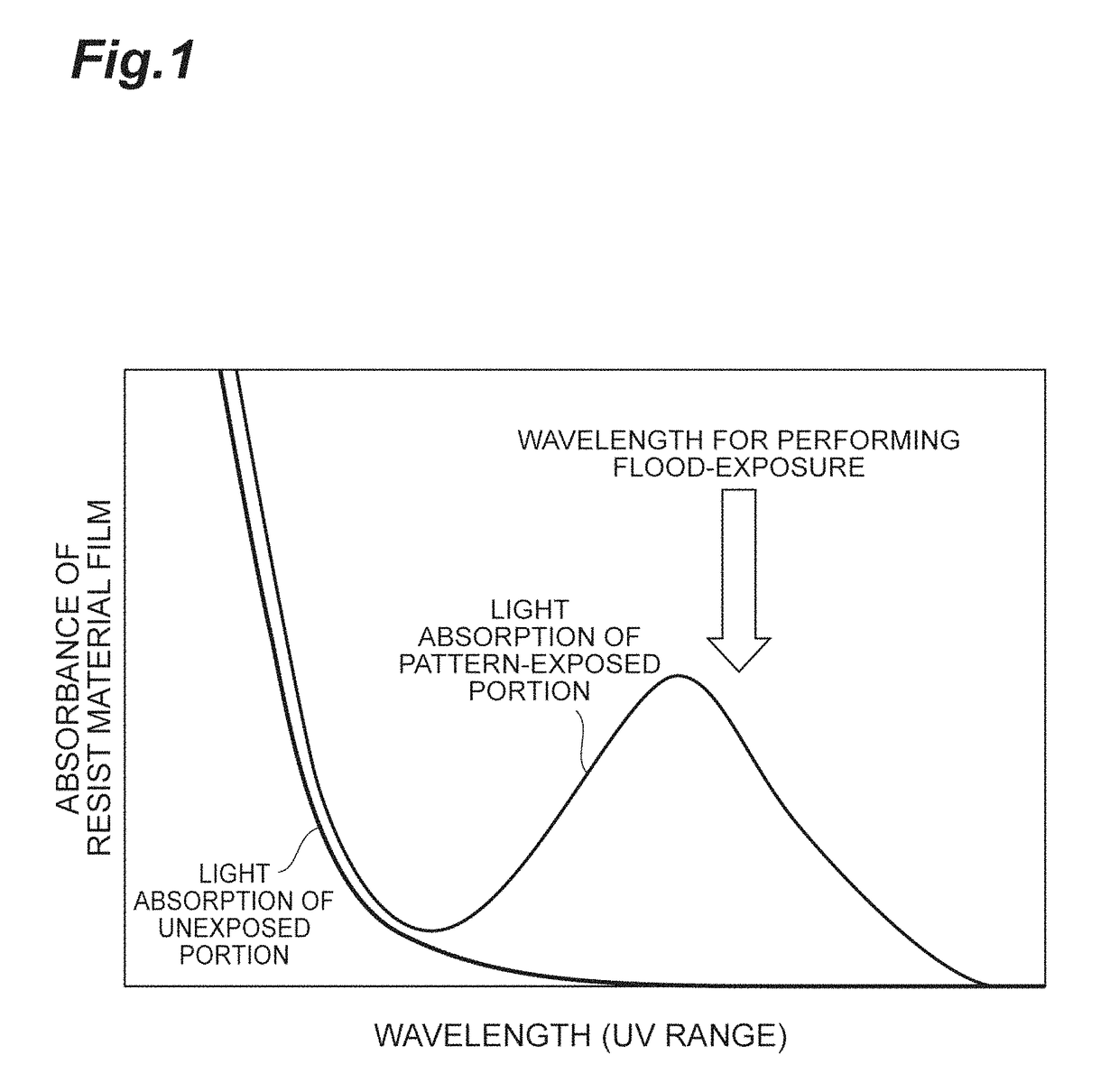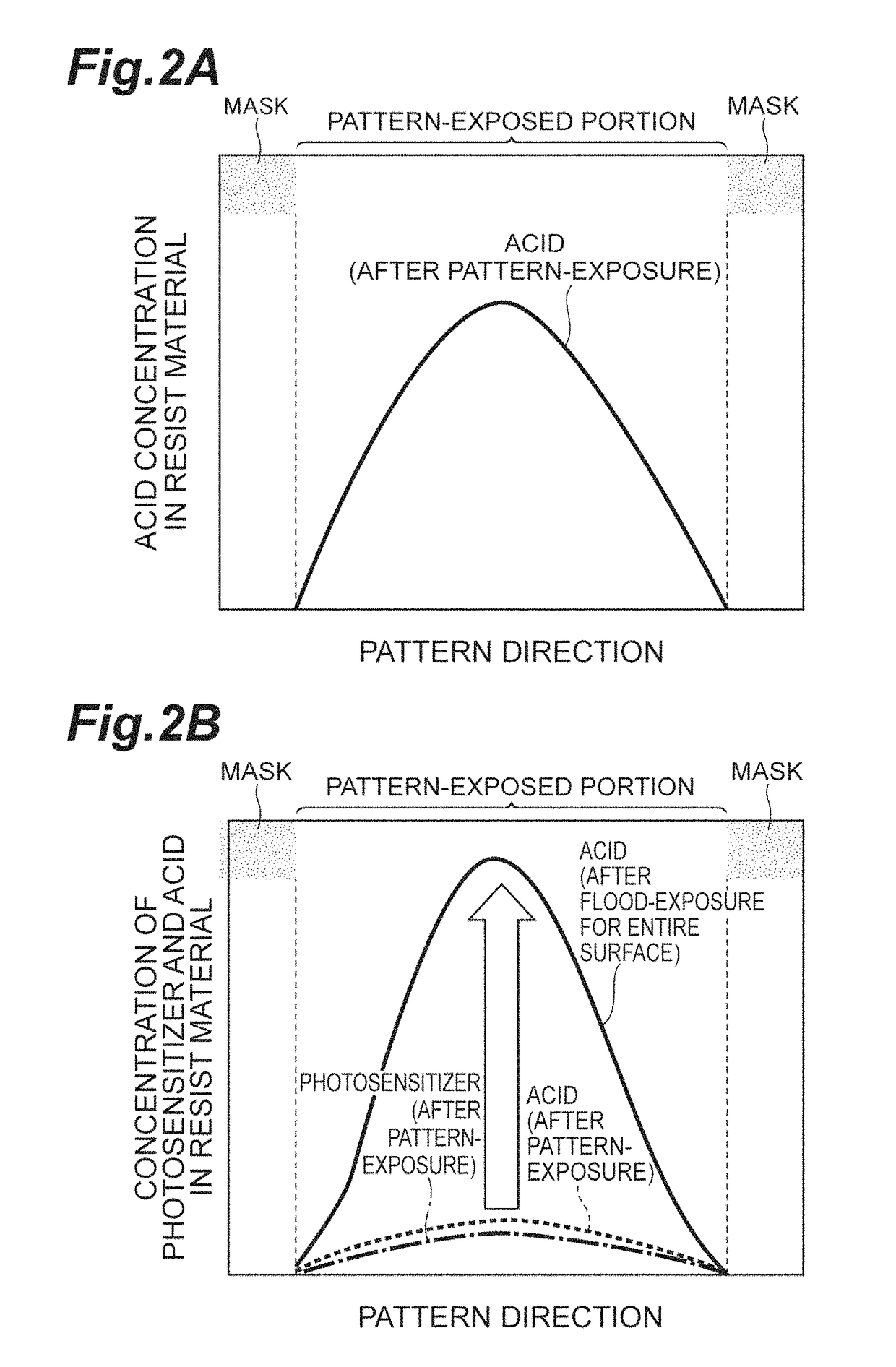Photosensitization chemical-amplification type resist material, method for forming pattern using same, semiconductor device, mask for lithography, and template for nanoimprinting
a chemical amplification and resist material technology, applied in the field of photosensitization chemical amplification type resist material, a pattern formation method, can solve the problems of power and sensitivity, exposure treatment takes a long time, and euv lithography has not yet been put to practical use, etc., to achieve excellent lithography characteristics and high sensitivity
- Summary
- Abstract
- Description
- Claims
- Application Information
AI Technical Summary
Benefits of technology
Problems solved by technology
Method used
Image
Examples
first embodiment
[0033]The photosensitization chemical-amplification type resist material according to the present embodiment (hereinafter, simply referred to as a “resist material” in some cases) contains (1) a base component and (2) a component generating a photosensitizer and an acid by exposure.
[0034](1) Base Component
[0035]In the present embodiment, the (1) base component may be an organic compound or an inorganic compound. The organic compound may be a polymer compound or a low-molecular weight compound. It is desired that the base component does not excessively absorb the first radiation in the pattern-exposure and enables the formation of a resist pattern with a shape having sufficiently high verticality. Furthermore, it is desired that the base component absorbs little the second radiation in the flood-exposure and hardly causes an unnecessary sensitization reaction in an unexposed portion at the time of flood-exposure.
[0036]The polymer compound is a compound which has a weight average mole...
second embodiment
[0180]A photosensitization chemical-amplification type resist material (hereinafter, simply referred to as a “resist material” in some cases) of the present embodiment contains (1′) a base component which makes a pattern-exposed portion soluble or insoluble in a developer after the baking step.
[0181](1′) Base Component
[0182]The (1′) base component may be an organic compound or an inorganic compound. Furthermore, the organic compound may be a polymer compound or a low-molecular weight compound. The (1′) base component has, among three groups consisting of (d) an acid-photosensitizer generating group, (e) a precursor group, and (f) a photoacid generating group, only the group (d), any two groups, or all of the groups (d) to (f) described below. That is, in the present embodiment, the base component is an organic or inorganic compound to which the following groups (d) to (f) are bonded. The base component may have the following groups (d) to (f) in a single molecule (or a single partic...
example 1
[0381]32.19 parts by mass (0.44 parts by mole) of the following GBLMA, 23.86 parts by mass (0.24 parts by mole) of the following MAMA, and 21.29 parts by mass (0.21 parts by mole) of the following HAMA as methyl methacrylates to which a protecting group was bonded and 22.66 parts by mass (0.11 parts by mole) of the following PBpS-F2MAS as methyl methacrylate to which a photoacid generating group was bonded were mixed together and radically polymerized, thereby synthesizing a methyl methacrylate-based polymer compound (polymer compound P) having the (f) photoacid generating group as the component (1′). The obtained methyl methacrylate-based polymer compound had a weight average molecular weight (Mw) of 24,800 and a molecular weight distribution (Mw / Mn) of 3.08. Herein, the above Mw and Mw / Mn were measured through gel permeation chromatography (GPC) under the following conditions by using a calibration curve based on standard polystyrene.
Device: HPLC (manufactured by Shimadzu Corporat...
PUM
| Property | Measurement | Unit |
|---|---|---|
| wavelength | aaaaa | aaaaa |
| wavelength | aaaaa | aaaaa |
| refractive index | aaaaa | aaaaa |
Abstract
Description
Claims
Application Information
 Login to View More
Login to View More - R&D
- Intellectual Property
- Life Sciences
- Materials
- Tech Scout
- Unparalleled Data Quality
- Higher Quality Content
- 60% Fewer Hallucinations
Browse by: Latest US Patents, China's latest patents, Technical Efficacy Thesaurus, Application Domain, Technology Topic, Popular Technical Reports.
© 2025 PatSnap. All rights reserved.Legal|Privacy policy|Modern Slavery Act Transparency Statement|Sitemap|About US| Contact US: help@patsnap.com



